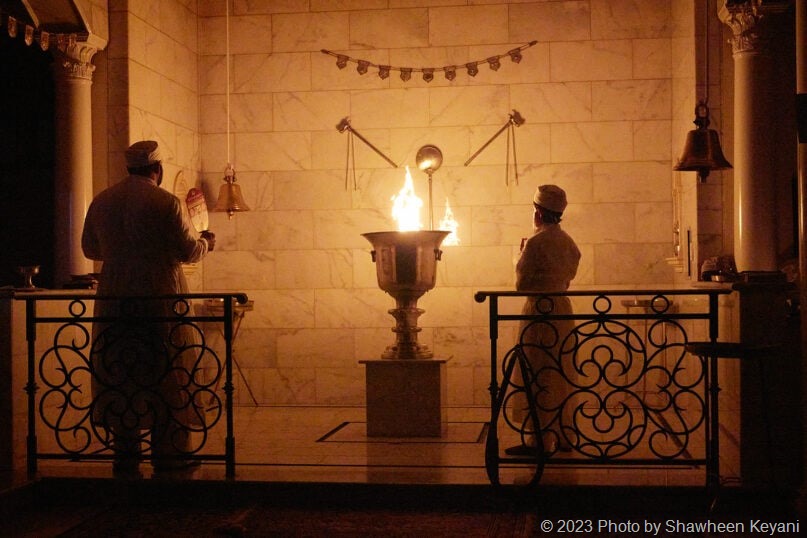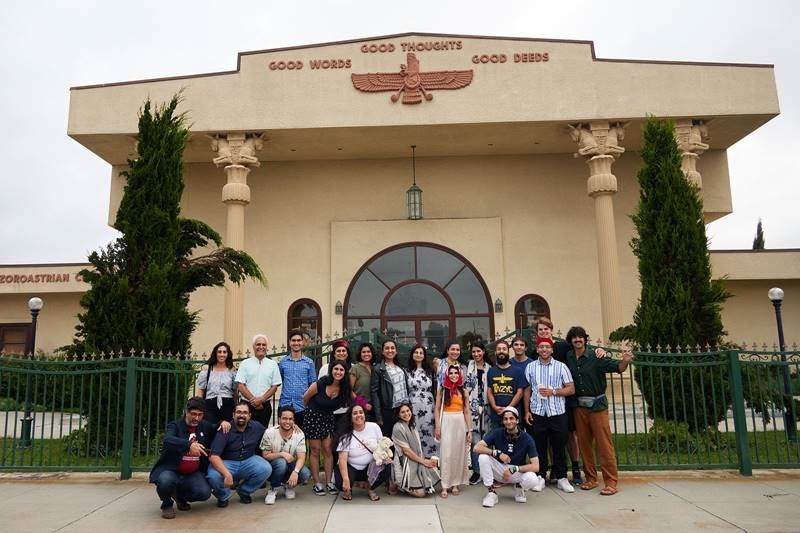Looking to ensure a future for the aging, mostly immigrant Zoroastrian community, the faith’s leaders in the United States are rallying young Zoroastrians to make friendships across demographic lines and rediscover their spiritual heritage.
The fire altar at the Zoroastrian Association of California in Orange, California, on Sept. 1, 2023. Photo by Shawheen Keyani
October 3, 2023
By
(RNS) — Shawheen Keyani boarded a bus from San Diego to San Jose, knowing nothing about his fellow passengers except that they all shared the same ancient faith. He was one of roughly 20 young people, Zoroastrians who had wandered away from their childhood faith, setting out on a multiday, cross-California road trip to visit six Zoroastrian houses of worship, known as dar-e-mehrs.
It had been more than 15 years since Keyani, 32, had stepped foot in a dar-e-mehr, and he wasn’t sure what to expect.
“I was thinking, ‘Well, this is technically my people, and I’ve been really out of touch,’” said Keyani. “And I sort of went into the road trip with a hypothesis for myself: Am I going to feel anything?”
Keyani and the others on the trip are members of the 3,000-year-old monotheistic religion with its origins in central Asia that many scholars believe had influence on ancient Jews’ belief in monotheism. Emphasizing the struggle between good and evil, Zoroastrians follow the teachings of the prophet Zarathustra, pray in dar-e-mehrs — also known as fire temples, because they house a perpetual flame — and embrace the creed “good thoughts, good words, good deeds.”
RELATED: ‘Vacationing’ to reconnect with India’s Zoroastrian culture
There are only 150,000 Zoroastrians estimated worldwide, with most living in India. There are an estimated 25,000 believers in North America.
The trip, which took place over Labor Day weekend this year, was organized by Zoroastrian Youth of North America and was meant as an opportunity for Zoroastrians ages 21-35 to meet one another and connect over shared traditions. The tour started off in San Diego and traveled up the California coast, ending in Sacramento.
Keyani grew up as part of the Zoroastrian minority in northern Tehran, Iran. When he was 15, he came alone to the United States to attend boarding school. Wanting to fit in, he started going by “Shawn” rather than Shawheen. After graduating from school, he eventually opened his own photography business. He knew only a few other Iranians and had no Zoroastrian friends.
“I embraced this idea that by being Zoroastrian, I’m sort of like a dodo. I’m just this one-of-a-kind thing and if I bump into another one, it’s really crazy,” said Keyani.
But after hearing about the trip from his mother, Keyani signed up to ride on the ZYNA bus. Along the way he met other Zoroastrians, visited California’s six fire temples and rediscovered his community. Seeing the different prayer rooms with their marble floors, Persian rugs and large fire altars was especially impactful for Keyani.
“I just had this feeling like ‘Wow, my religion is actually really cool. I forgot about this,’” said Keyani. “Our place of worship has this epic goblet of fire in the middle.”
The California trip was just one of several recent efforts by ZYNA to engage Zoroastrian youth.
A group touring California dar-e-mehrs poses together at the California Zoroastrian Center in Orange County, California, on Sept. 1, 2023. Photo courtesy of ZYNA
ZYNA is part of FEZANA, Federation of Zoroastrian Associations of North America, an organization established in 1987 to serve the needs of Zoroastrians living in North America, many of them immigrants from Iran and India. There are 27 member associations across the United States and Canada.
Arzan Sam Wadia, 50, who became FEZANA’s president in 2020, has been instrumental in ZYNA’s success.
“We really ran ZYNA for the first three or four years as a start-up,” said Wadia.
Wadia, an architect and urban designer, was born in Mumbai, India, and moved to Brooklyn, New York, 25 years ago. He has been involved in Zoroastrian youth engagement since 2013. In 2019, he brought together young Zoroastrians to run FEZANA’s social media, which led him to establish ZYNA.
“Everyone who was president before me was in their 60s. The oldest one is in their late 80s. In a way, it’s kind of passing the baton to the next generation,” said Wadia. “When I became president, I encouraged younger people to step up.”
For Wadia, ZYNA’s success is crucial not only to continuing FEZANA’s work but ensuring the longevity of the Zoroastrian community, especially in light of an aging Zoroastrian population.
Wadia and FEZANA’s leadership have been planning their youth movement using the results of a community survey titled “Gen Z and Beyond: A Survey for Every Generation.” The study, conducted over 18 months beginning in 2021, asked nearly 5,000 Zoroastrians of various demographics everything from how they relate to the core tenets of the faith to their educational experiences and professional careers.
The survey found that North American Zoroastrians tend to be more progressive when it comes to intermarriage and observing certain religious laws than those in India. A majority of respondents consider themselves active practitioners of the religion, but that sentiment was reflected least among Zoroastrians ages 18-25.
Arshya Bakhtiani, a 26-year-old artist in Fullerton, California, found herself discussing spirituality with other participants on the ZYNA road trip. Up until that point she had never really considered herself religious.
“We were talking about spirituality, about who we are as individuals and what we see in our culture. It was pretty wholesome and felt very enlightening.” said Bakhtiani. “It brought a passion to me that I never thought I could have.”
Bakhtiani said she plans to design a Zoroastrian calendar to help others keep track of the months and holidays observed in Zoroastrianism.
The Gen Z survey also exposed a dynamic in which a majority of North Americans view the relationship between Zoroastrians from India, known as Parsis, and Iranian Zoroastrians as “mixed.” In the Zoroastrian diaspora, the two communities often exist in separate spaces due to differences in language, cultures and overall experiences.
However, Zoroastrian youth organizations such as ZYNA are challenging the status quo.
Farzin Avari, a co-chair of ZYNA and a high school science teacher in Atlanta, was born in India and raised in the United States by Parsi parents. “We have the opportunity to create the culture that we want. We can reach out to the other side of the community that we have not been able to connect with,” said Avari, 34. “I didn’t have any Persian friends until I became involved with ZYNA, and my parents definitely don’t have Persian friends. It’s a way for us to bring our community back together and rebuild and reimagine it the way we want.”
For Keyani, spending time with Parsi Zoroastrians on the road trip was also a new experience. “In the past I was told that there’s a big difference between Parsis and Iranians, and I learned, at least in our generation, there isn’t,” said Keyani. “We’re just all Zoroastrians at the end of the day.”
That sense of identifying with his faith was Keyani’s main takeaway from the five-day trip around California. He took a new pride in his Zoroastrianism and felt he had made lifelong friendships and rediscovered his childhood faith.
“I was surprised because I found myself finding something that I didn’t realize was missing,” said Keyani. “And really, on some primal level, seeing some of these people felt like I’ve known them for thousands of years.”


